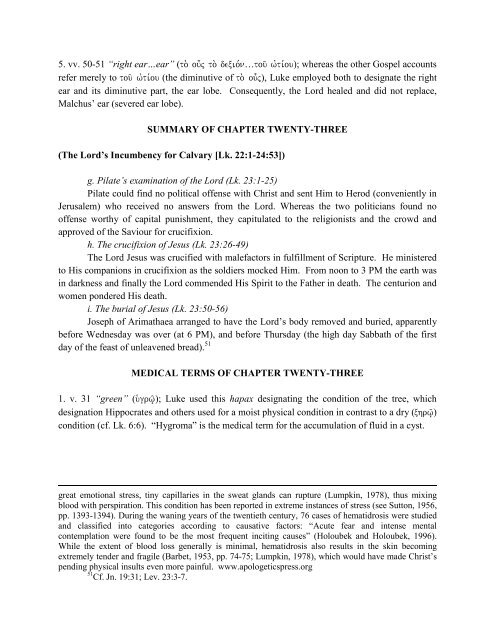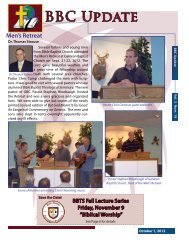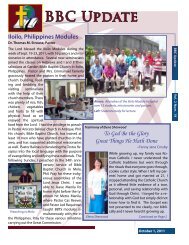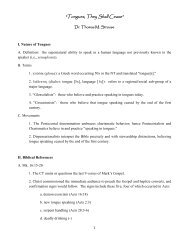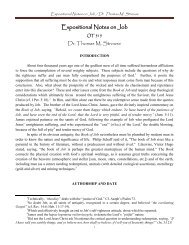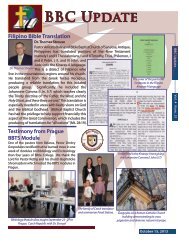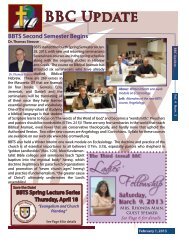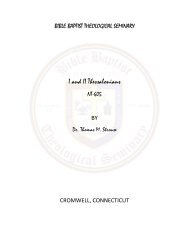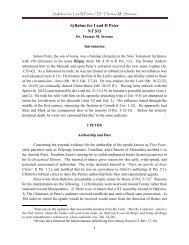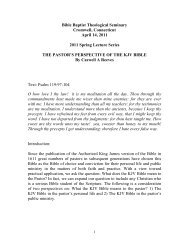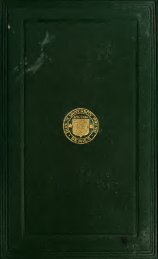Commentary on Luke's Gospel with Emphasis on Medical Terms
Commentary on Luke's Gospel with Emphasis on Medical Terms
Commentary on Luke's Gospel with Emphasis on Medical Terms
Create successful ePaper yourself
Turn your PDF publications into a flip-book with our unique Google optimized e-Paper software.
5. vv. 50-51 “right ear…ear” (to. ou=j to. dexio,n…tou/ wvti,ou); whereas the other <strong>Gospel</strong> accounts<br />
refer merely to tou/ wvti,ou (the diminutive of to. ou=j), Luke employed both to designate the right<br />
ear and its diminutive part, the ear lobe. C<strong>on</strong>sequently, the Lord healed and did not replace,<br />
Malchus’ ear (severed ear lobe).<br />
SUMMARY OF CHAPTER TWENTY-THREE<br />
(The Lord’s Incumbency for Calvary [Lk. 22:1-24:53])<br />
g. Pilate’s examinati<strong>on</strong> of the Lord (Lk. 23:1-25)<br />
Pilate could find no political offense <strong>with</strong> Christ and sent Him to Herod (c<strong>on</strong>veniently in<br />
Jerusalem) who received no answers from the Lord. Whereas the two politicians found no<br />
offense worthy of capital punishment, they capitulated to the religi<strong>on</strong>ists and the crowd and<br />
approved of the Saviour for crucifixi<strong>on</strong>.<br />
h. The crucifixi<strong>on</strong> of Jesus (Lk. 23:26-49)<br />
The Lord Jesus was crucified <strong>with</strong> malefactors in fulfillment of Scripture. He ministered<br />
to His compani<strong>on</strong>s in crucifixi<strong>on</strong> as the soldiers mocked Him. From no<strong>on</strong> to 3 PM the earth was<br />
in darkness and finally the Lord commended His Spirit to the Father in death. The centuri<strong>on</strong> and<br />
women p<strong>on</strong>dered His death.<br />
i. The burial of Jesus (Lk. 23:50-56)<br />
Joseph of Arimathaea arranged to have the Lord’s body removed and buried, apparently<br />
before Wednesday was over (at 6 PM), and before Thursday (the high day Sabbath of the first<br />
day of the feast of unleavened bread). 51<br />
MEDICAL TERMS OF CHAPTER TWENTY-THREE<br />
1. v. 31 “green” (u`grw/|); Luke used this hapax designating the c<strong>on</strong>diti<strong>on</strong> of the tree, which<br />
designati<strong>on</strong> Hippocrates and others used for a moist physical c<strong>on</strong>diti<strong>on</strong> in c<strong>on</strong>trast to a dry (xhrw/|)<br />
c<strong>on</strong>diti<strong>on</strong> (cf. Lk. 6:6). “Hygroma” is the medical term for the accumulati<strong>on</strong> of fluid in a cyst.<br />
great emoti<strong>on</strong>al stress, tiny capillaries in the sweat glands can rupture (Lumpkin, 1978), thus mixing<br />
blood <strong>with</strong> perspirati<strong>on</strong>. This c<strong>on</strong>diti<strong>on</strong> has been reported in extreme instances of stress (see Sutt<strong>on</strong>, 1956,<br />
pp. 1393-1394). During the waning years of the twentieth century, 76 cases of hematidrosis were studied<br />
and classified into categories according to causative factors: “Acute fear and intense mental<br />
c<strong>on</strong>templati<strong>on</strong> were found to be the most frequent inciting causes” (Holoubek and Holoubek, 1996).<br />
While the extent of blood loss generally is minimal, hematidrosis also results in the skin becoming<br />
extremely tender and fragile (Barbet, 1953, pp. 74-75; Lumpkin, 1978), which would have made Christ’s<br />
pending physical insults even more painful. www.apologeticspress.org<br />
51 Cf. Jn. 19:31; Lev. 23:3-7.


